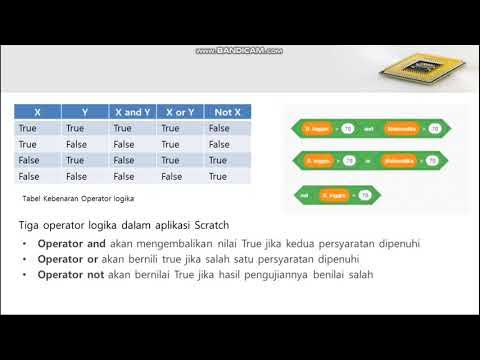Belajar Python [Dasar] - 10 - Operasi Komparasi
Summary
TLDRIn this Python tutorial, the speaker explains comparison operators such as greater than, less than, equal to, and not equal to, using practical examples to demonstrate how to perform comparisons. The video also covers the difference between `is` and `is not`, emphasizing their role in comparing object identities rather than values. Throughout the lesson, viewers are guided through various code snippets to understand the concepts clearly, especially the behavior of memory and efficiency in Python. The tutorial is designed for beginners to help them grasp essential comparison operations and object identity in Python programming.
Takeaways
- 😀 Comparison operations return either 'True' or 'False' in Python.
- 😀 The 'greater than' operator (>) checks if a value on the left side is greater than the value on the right side.
- 😀 The 'less than' operator (<) checks if a value on the left side is smaller than the value on the right side.
- 😀 The 'greater than or equal to' (>=) operator checks if a value is greater than or equal to the value on the right side.
- 😀 The 'less than or equal to' (<=) operator checks if a value is less than or equal to the value on the right side.
- 😀 The equality operator (==) checks if two values are equal.
- 😀 The 'not equal to' (!=) operator checks if two values are different.
- 😀 The 'is' operator checks if two variables point to the same memory location (object identity).
- 😀 The 'is not' operator is the opposite of 'is' and checks if two variables do not point to the same memory location.
- 😀 It's recommended not to use the 'is' operator for comparing literals in Python, as it compares object identity rather than value equality.
Q & A
What are comparison operators in Python?
-Comparison operators in Python are used to compare two values and return a boolean value (True or False). These operators include greater than (>), less than (<), greater than or equal to (>=), less than or equal to (<=), equal to (==), and not equal to (!=).
What is the result of a comparison operation in Python?
-The result of a comparison operation in Python is either True or False, based on whether the condition being compared is met.
Can you explain how the 'is' operator works in Python?
-'is' checks whether two variables reference the same object in memory, not just if their values are equal. It compares object identities.
How is 'is' different from '==' in Python?
-'==' checks if the values of two variables are the same, while 'is' checks if both variables point to the same object in memory.
What does the 'is not' operator do?
-'is not' checks if two variables do not refer to the same object in memory. It is the negation of 'is'.
What is the significance of comparison operators like 'greater than or equal to' (>=) and 'less than or equal to' (<=)?
-These operators check whether one value is greater than or equal to, or less than or equal to another value. They are useful when you need to include a specific boundary value in a comparison.
When should you use 'is' and 'is not' for comparison?
-'is' and 'is not' should be used when comparing object identities (i.e., checking if two variables reference the same object in memory). They are not suitable for comparing simple values like numbers or strings.
What does the '==' operator do in Python?
-'==' checks whether the values of two variables are equal. It is commonly used for comparing primitive data types, such as integers and strings.
Why does the speaker suggest not using 'is' with literals in Python 3.5 and above?
-In Python 3.5 and later, using 'is' with literals may cause a warning because 'is' should be used for comparing object identities, not for literal values like numbers or strings.
What is the main difference between comparing values and comparing objects in Python?
-Comparing values (with '==') checks if two variables hold the same data, whereas comparing objects (with 'is') checks if two variables reference the exact same memory location.
Outlines

Dieser Bereich ist nur für Premium-Benutzer verfügbar. Bitte führen Sie ein Upgrade durch, um auf diesen Abschnitt zuzugreifen.
Upgrade durchführenMindmap

Dieser Bereich ist nur für Premium-Benutzer verfügbar. Bitte führen Sie ein Upgrade durch, um auf diesen Abschnitt zuzugreifen.
Upgrade durchführenKeywords

Dieser Bereich ist nur für Premium-Benutzer verfügbar. Bitte führen Sie ein Upgrade durch, um auf diesen Abschnitt zuzugreifen.
Upgrade durchführenHighlights

Dieser Bereich ist nur für Premium-Benutzer verfügbar. Bitte führen Sie ein Upgrade durch, um auf diesen Abschnitt zuzugreifen.
Upgrade durchführenTranscripts

Dieser Bereich ist nur für Premium-Benutzer verfügbar. Bitte führen Sie ein Upgrade durch, um auf diesen Abschnitt zuzugreifen.
Upgrade durchführenWeitere ähnliche Videos ansehen

Operator Perbandingan dan Logika

C_16 Operators in C - Part 4 | C Programming Tutorials

Informatika Kelas 8 Menggunakan Kondisi Percabangan Hal. 93-100

Comparison Operators in JavaScript Explained in Hindi | The Complete JavaScript Course | Ep.10

GCSE Computer Science Python #2 - Inputs, Outputs and Operators

Belajar Python [Dasar] - 12 - Latihan Komparasi dan Logika
5.0 / 5 (0 votes)
